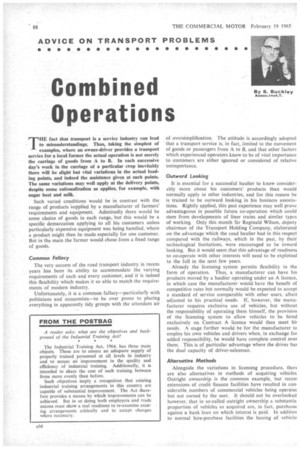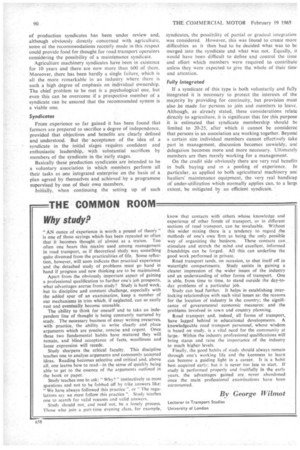Combined Operations
Page 90

Page 91

Page 92

If you've noticed an error in this article please click here to report it so we can fix it.
THE fact that transport is a service industry can lead to misunderstandings. Thus, taking the simplest of examples, where an owner-driver provides a transport service for a local farmer the actual operation is not merely the carriage of goods from A to B. In each successive day's work in the carriage of a particular crop inevitably there will be slight but vital variations in the actual loading points, and indeed the assistance given at such points. The same variations may weH apply at the delivery points, despite some rationalization as applies, for example, with sugar beet and milk.
Such varied conditions would be in contrast with the range of products supplied by a manufacturer of farmers' requirements and equipment. Admittedly there would be some choice of goods in each range, but this would be a specific demarcation applying to all his customers unless particularly expensive equipment was being handled, where a product might then be made especially for one customer. But in the main the farmer would chose from a fixed range of goods.
Common Fallacy The very success of the road transport industry in recent years has been its ability to accommodate the varying requirements of each and every customer, and it is indeed this flexibility which makes it so able to match the requirements of modern industry.
Unfortunately, it is a common fallacy—particularly with politicians and economists—to be over prone to placing everything in apparently tidy groups with the attendant air of oversimplification. The attitude is accordingly adopted that a transport service is, in fact, limited to the movement of goods or passengers from A to B, and that other factors which experienced operators know to be of vital importance to customers are either ignored or considered of relative unimportance.
Outward Looking
It is essential for a successful haulier to know considerably more about his customers' products than would normally apply in other industries, and for this reason he is trained to be outward looking in his business associations. Rightly applied, this past experience may well prove advantageous in possible future co-operation which could stem from developments of liner trains and similar types of working. Only this month Sir Reginald Wilson, deputy chairman of the Transport Holding Company, elaborated on the advantage which the road haulier had in this respect compared with the railways, which in the past, by their technological limitations, were encouraged to be inward looking. But it would seem that this advantage of readiness to co-operate with other interests will need to be exploited to the full in the next few years.
Already the licensing system permits flexibility in the form of operation. Thus, a manufacturer can have his products moved by a haulier operating under an A licence, in which case the manufacturer would have the benefit of competitive rates but normally would be expected to accept a standard of service comparable with other users, albeit adjusted to his practical needs. If, however, the manufacturer requires exclusive use of vehicles, but without the responsibility of operating them himself, the provision of the licensing system to allow vehicles to be hired exclusively on Contract A licence would then meet hi: needs. A stage further would be for the manufacturer to employ his own vehicles and drivers when, in exchange for added responsibility, he would have complete control over them. This is of particular advantage where the driver has the dual capacity of driver-salesman.
Alternative Methods Alongside the variations in licensing procedure, there are also alternatives in methods of acquiring vehicles Outright ownership is the common example, but receni extensions of credit finance facilities have resulted in con. siderable numbers of commercial vehicles being operatec but not owned by the user. It should not be overlooked however, that in so-called outright ownership a substantia proportion of vehicles so acquired are, in fact, purchasec against a bank loan on which interest is paid. In additior to normal hire-purchase facilities the leasing of vehicle! 'hen they never become the property of the user) is also n the increase.
Here again, the value of a service industry—in this case, redit finance—has to be weighed carefully in the same ray that the balance between hiring for one's transport r providing it oneself has to be determined. Where a :rvice is provided, then obviously the profit margin and verheads of the person providing the service has to be let in the charges made to the user. This would apply ) the interest charges incorporated in payments for credit nance facilities. Because these can be specifically defined, owever, they can be allowed to overshadow the savings y way of reduced responsibility and overall administration .hich cannot be so readily defined but are nevertheless ack to Hiring A further example of combined operations between :rvice industries can arise in connection with maintenance. his is a problem which often provides the major reason )r manufacturers and industrialists who have previously perated their own vehicles reverting back to hiring. It is Weed an aspect of transport operation which can be ndervalued, and not necessarily deliberately. In this :spect, though not in others, it is an unfortunate fact that le transport industry is made up of small units. .ccordingly, this has a direct bearing on the cost and Eciency with which maintenance can be carried out.
Reverting to the owner-driver providing for the needs f the local farmer, if he himself is mechanically minded; is indeed often the reason for him entering the industry— may well be capable of providing adequate maintenance imself. Incidentally, he may apparently do this :onomically only by being prepared to do two jobs for irtually one pay packet. To that extent his alleged low mintenance costs are understated. Equally, such a tuation could operate relatively adequately where the mt of vehicles is limited to a few, bearing in mind that le average throughout the industry is four vehicles per aerator.
laintenance Depot When it becomes no longer possible for the owner-driver
• do his own maintenance personally because of the crease in the size of the fleet, then the next stage in the :velopment of his business is to engage staff for that it-pose. For many years the type of organization operats, say. 10 to 30 vehicles has been a common feature of le industry, and in most cases a maintenance depot of irts has been provided.
But even where adequate finance and skilled labour are railable—two very big suppositions—there are inherent sadvantages to many such arrangements. Any mainnance equipment thereby provided—which will be only considerable cost—must inevitably be under-utilized. owever. because of the urgency of transport operation any expensive items of maintenance equipment are sential if jobs are to be done quickly and adequately, ut such occasions may, in fact, be quite infrequent, ;spite the urgency when they do arise. Similarly, it is fficult, if not impossible, to organize maintenance work in steady flow for relatively small fleets of vehicles, thereby miring that skilled men at appropriate rates of pay are nployed only on skilled work.
Excluding the relatively few examples where a haulier r ancillary user is in such a large way of business that can organize maintenance depots to service, say, 50 to 10 vehicles, there are alternative procedures-for the nailer user. As a variation to the hiring on contract of :hides it is also possible in some areas to arrange for maintenance to one's own vehicles to be done by an outside agency on contract. According to circumstances this may be the actual manufacturer of the vehicle, his distributor or agent.
Statesmanlike More recently consideration has been given to another alternative to the problem of providing adequate main tenance economically—namely, a form of syndicate in which otherwise competing hauliers combine their efforts to set up such a maintenance service. Such an exercise obviously demands a statesmanlike attitude from operators who by their very success have proved their individuality and resourcefulness. But where advantage is to be gained by such co-operation, they will be sufficiently businesslike to take it.
Agriculture and transport are two industries which have much in common both as to their size and geographical diversity. Moreover, farmers—like hauliers—are robust individualists not immediately given to co-operating with competitors. Nevertheless, they have in post-war years made considerable strides in just such collaboration through such organizations as the Agricultural Central Co-operative Association. More recently the formation of production syndicates has been under review and, although obviously directly concerned with agriculture, some of the recommendations recently made in this respect could provide food for thought for road transport operators considering the possibility of a maintenance syndicate.
Agriculture machinery syndicates have been in existence for 10 years and there are now more than 600 of them. Moreover, there has been hardly a single failure, which is all the more remarkable in an industry where there is such a high degree of emphasis on individual ownership. The chief problem to be met is a psychological one, but even this can be overcome if a prospective member of a syndicate can be assured that the recommended system is a viable one.
Syndicates
From experience so far gained it has been found that farmers are prepared to sacrifice a degree of independence, provided that objectives and benefits are clearly defined and understood. But the acceptance of the idea of a syndicate in the initial stages requires confident and enthusiastic leadership, with substantial sacrifices by members of the syndicate in the early stages.
Basically these production syndicates are intended to be a voluntary association in which members perform all their tasks as one integrated enterprise on the basis of a plan agreed by themselves and achieved by a programme supervised by one of their own members.
Initially, when continuing the setting up of such
syndicates, the possibility of partial or gradual integration was considered. However, this was found to create more difficulties as it then had to be decided what was to be merged into the syndicate and what was not. Equally, it would have been difficult to define and control the time and effort which members were required to contribute unless they were expected to give the whole of their time and attention.
Fully Integrated
If a syndicate of this type is both voluntarily and fully integrated it is necessary to protect the interests of the majority by providing for continuity, but provision must also be made for persons to join and members to leave. Although, as already stated, these considerations relate directly to agriculture, it is significant that for this purpose it is estimated that syndicate membership should be limited to 20-25, after which it cannot be considered that persons in an association are working together. Beyond a certain size individual members cannot effectively take part in management, discussion becomes unwieldy; and delegation becomes more and more necessary. Ultimately members are then merely working for a management.
On the credit side obviously there are very real benefits in bulk buying and in a pooling of experience. In particular, as applied to both agricultural machinery anc hauliers' maintenance equipment, the very real handicap of under-utilization which normally applies can, to a law extent, be mitigated by an efficient syndicate.




































































































































